Santoshi


Santoshi Mata is a relatively new goddess in the Hindu pantheon. She is venerated as "the Mother of Happiness",the meaning of her name. She is particularly worshipped by women of India and Nepal. A vrata (ritual fast) called the Santoshi Maa vrata performed by women on 16 consecutive Fridays wins the goddess' favour.
She emerged as the goddess in the early 1960s. Her prayer initially spread through word of mouth, vrata-pamphlet literature, and poster art. Her vrata was gaining popularity with North Indian women. However, it was the 1975 Bollywood film Jai Santoshi Maa ("Hail to Santoshi Maa")—narrating the story of the goddess and her ardent devotee Satyavati—which propelled this then little-known "new" goddess to the heights of devotional fervour. With the rising popularity of the film, she entered the pan-Indian Hindu pantheon and her images and shrines were incorporated in Hindu temples. The film portrayed the goddess to be the daughter of the popular Hindu god Ganesha and related her to the Raksha Bandhan festival. The 1975 film Jai Santoshi Maa glorified her. The screenings of the film were accompanied by religious rituals by the audience. Some of the audience entered the theatre barefoot, as in a Hindu temple, and small shrines and temples dedicated to the goddess, started springing up all over North India. The film attained cult status and years after its release, special matinee Friday screenings were organized for women, who observed the goddess' Friday vrata (ritual fast) and engaged in her worship. The success of this low-budget film and media reports of the "sudden emergence of a modern celluloid goddess" resulted in scholarly interest in Santoshi Mata.